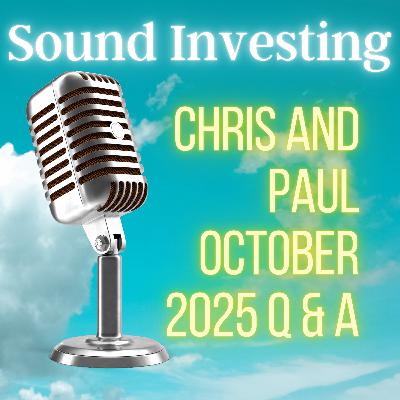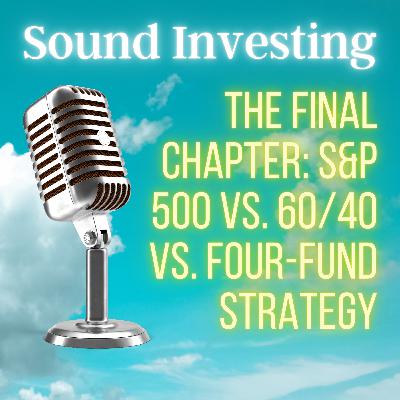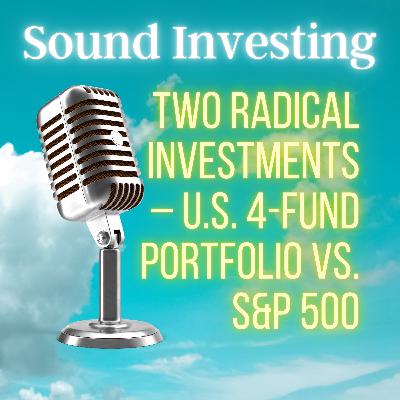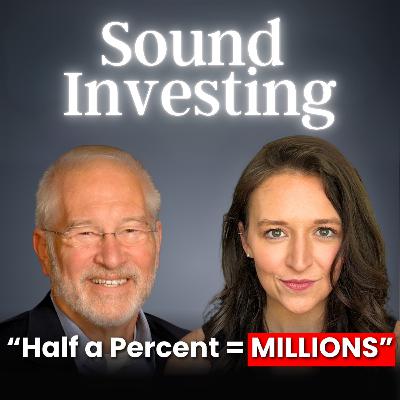Discover Sound Investing
Sound Investing

523 Episodes
Reverse
Over the last couple of weeks, I’ve been recording a series of Q&As that came out of a presentation I gave in November for the American Association of Individual Investors — AAII.At the end of that nearly two-hour talk, I promised that I’d do a podcast answering every single question that came in. Well… there were 36 questions. That’s a little too much for one episode, so we broke them into three parts.This is Part 3 — the final 12 questions. If you haven’t heard Parts 1 and 2 yet, we’ll link those in the show notes so you can catch up.Before we jump in, I just want to say: I’m a huge fan of AAII. I started teaching their local chapters way back in 1984, and over the years I think I’ve presented to just about every chapter in the country — sometimes in person, sometimes by Zoom — but always to people who are genuinely committed to learning how investing works.If you’ve never checked out AAII, I’ll include a link in the notes for a low-cost trial membership. Take a look around and see if it’s a resource that fits your investing journey.Alright — let’s get to the last 12.Will you develop strategies using the equal-weighted S&P 500? 01:44Can you recommend advisors who follow your strategy? 07:20Should I move mutual funds to ETFs in taxable accounts despite taxes? 11:26With markets at highs, should I keep dollar-cost averaging or rebalance? 16:17What portfolio fits 10 years to retire and 20–30 years of decumulation? 24:08Will the configurator shift to only Avantis/DFA funds in 2026? 30:37What does “inflation-adjusted fixed withdrawals” mean? 33:56How should I invest an inheritance for kids/grandkids ages 2–45? 38:21Ultimate Buy-and-Hold vs. two- or four-fund strategies — which is better? 49:03Should political conditions change retirement portfolio decisions? 59:12How do I find a fee-based/hourly advisor (Rhode Island question)? 1:05:56Should very conservative 91-year-olds move beyond bonds and cash? 1:13:28Part 1 of the AAII Q&A Series Part 2 of the AAII Q&A Series AAII trial membership offer (the ~$2 first month deal) Boot Camp series hub Fine-Tuning Your Asset Allocation table / lessonSound Investing / portfolio decade return tables — Fixed vs. Variable Withdrawal episode/article H-2A table referenced in Q9 Chris Pedersen Boot Camp presentation (Two-Fund for Life) Garrett Planning Network advisor directory HelloNectarine hourly advisor platform PlanVision / Mark Zoril reference
Paul continues his three-part series responding to questions from his November 8 AAII presentation. In this episode, he digs into risk-parity portfolios, the role of gold, how the 10-Fund Strategy compares to the S&P 500, growth vs. value, rebalancing discipline, and how to choose the right bond allocation in retirement. If you were at the AAII event, you’ll find the exact 12 questions listed below so you can jump straight to your topic.12 AAII Questions CoveredThoughts on risk-parity portfolios during retirement distributions? 2:12Was the 10-Fund Strategy originally meant to mirror 60/40? 14:51Should investors add gold (IAU) after its recent streak? 21:40What is a double-rung bond ladder? 24:03Which of the nine portfolios has the best return per unit of risk? 26:36Analysis of growth funds outperforming over the last decade? 31:36How to invest new money when the economic outlook looks uncertain? 36:40Will the AAII slide deck be available? 38:54How often do you rebalance? 39:25How do you tune out the noise and stay the course? 41:13How to choose your bond allocation in the distribution phase? 45:25Can you share ETFs for the bond portion of a retirement portfolio? 52:12Resources MentionedAAII presentation slides10-Fund vs. S&P long-term comparison Fine-Tuning Your Asset Allocation tablesSound Investing tablesRetirement withdrawal tablesLifetime Investment Strategy calculatorBest-in-Class ETF recommendations
Recorded from our new home on Bainbridge Island and released on Thanksgiving, this episode is equal parts gratitude and practical investing help. I open with my annual tradition of writing a fresh Thanksgiving list—people, communities, and institutions that have shaped my life and this work. I’m especially thankful for you, the DIY investors who keep showing up to learn, ask thoughtful questions, and hopefully staying the course.I also share appreciation for the resources that support disciplined investing—Morningstar, the Bogleheads community, and the American Association of Individual Investors (AAII). After a recent AAII presentation (over 150 attendees), we ran out of time for a live Q&A. I promised to respond to every legitimate question, so this episode kicks off a multi-part series answering them in depth.Here are the first 12 AAII questions covered in today’s episode:(9:42) What alterations in portfolio construction do you recommend in transition from accumulation to distribution in order to maximize diversification of uncorrelated assets, safe withdrawal rates, and spending? Table h2a (21:21) I’m a huge fan of your U.S. two-fund portfolio. Why is diversification between large-cap growth and small-cap value so important, while diversification between VTSAX and AVUS (within the same asset class) is not? Should we diversify fund selection within the same asset class? Table K2b(26:49) Have you considered creating a quilt chart for the Ultimate Buy-and-Hold portfolios with a 70/30 U.S./international split? Table K1a and H2a and H2b(32:04) You appear to have avoided any mention of mid-cap. Should we be ignoring mid-cap funds?(33:35) What do you think about adding alternative investments to the portfolio (for example, managed futures)?(38:39) Are your recommendations for everyone, or does the game change when you have a pension for life?(43:07) I was fighting with the Zoom link and arrived 25 minutes into the presentation. Will a video recording be available to participants?(44:08) What would you expect the difference between the S&P 500 cap-weighted index (VFINX)and the S&P 500 equal-weighted index (VADAX) to be?(49:53) The four-fund portfolios are equal-weighted across their asset classes, which results in a value tilt overall. Why weigh them equally?(54:35) One might think that adding international large-cap growth and international small-cap value to the two-fund approach would improve results. Does international allocation mainly reduce volatility/drawdown length, or also increase returns? H2a and H2b(56:26) Can you buy DFA and Avantis funds at Charles Schwab?(58:40) What should you do if you have a lump sum to invest today, but current market highs make entry uncomfortable? https://awealthofcommonsense.com/2025/11/do-we-need-a-long-bear-market/
Paul Merriman brings 60+ years of investing experience to the Retire Today podcast, breaking down what really determines retirement success. Most investors think it’s about picking the right fund or timing the market—but Paul says the biggest threats aren’t headlines. They’re costs and emotions.In the 1960s, investors routinely paid 8.5% to buy a mutual fund. Today fees are far lower, but the impact is still huge. Paul notes that even a 1% difference in expenses “can cost you about $3.5 million over a lifetime” because compounding works both for you and against you.Behavior can cost even more. “When the market goes down, people panic,” Paul explains. Selling in a downturn—the “I just can’t take it anymore” moment—means locking in losses and missing the recovery. His advice: don’t time the market. Build a plan you can actually stick to.When asked what separates retirees who thrive from those who struggle, Paul’s answer is simple: education. What you learn and who you learn it from shapes your decisions—and helps you stay calm when markets get rough. That’s why his nonprofit work focuses on teaching diversified, simple, low-cost strategies through guides like Sound Investing Portfolios and We’re Talking Millions!Paul once promoted a 10-fund “Ultimate Buy-and-Hold” portfolio, but even John Bogle told him it was too complex. After testing simpler versions, Paul found that two-, four-, and six-fund portfolios often matched or beat the original. You can explore these models at PaulMerriman.com/portfolios. The takeaway: simplicity makes discipline easier.We also discussed retirement withdrawals. Paul recommends a flexible approach: take a bit less after down years and a bit more when markets are strong. This can reduce stress and help your portfolio last. “If you know how long you’re likely to live and how much you have,” he says, “that knowledge gives you freedom—not fear.”If you’re approaching retirement, here’s Paul’s short list:Diversify with low-cost index funds. Focus on the right mix, not the perfect pick.Match risk to reality. Choose a stock/bond split you can live with in bad markets.Use flexible withdrawals. Adjust spending based on market conditions.Keep behavior boring. Automate rebalancing and ignore predictions.Invest in education. Knowledge keeps emotions from running the show.You’ve worked hard to build your savings. Now build a plan that works just as hard—quietly, efficiently, and with confidence. Watch the full conversation on YouTube for more on fees, behavior, portfolio design, and practical withdrawal strategies.
First, a big thank-you to everyone who joined me for the AAII presentation last Saturday. I appreciate your patience during my rocky Zoom start—and a special shout-out to Suzette Moskwa, who saved the day by running the slides!As promised, I’m following up on your chat comments and questions from the session. This week’s focus is on your insights; in the next couple of weeks, I’ll share a full Q&A edition covering listener questions on portfolio construction, diversification, and long-term investing strategy.Key Takeaways from This Week’s DiscussionETFs vs. Mutual Funds — Tax Efficiency MattersMutual funds often create higher annual taxes in taxable accounts. ETFs and index funds are more tax-efficient because of how they handle capital gains—saving investors up to 1% a year. Keep mutual funds inside IRAs to avoid unnecessary taxes.Equal-Weighted vs. Cap-Weighted PortfoliosThe Invesco Equal Weighted S&P 500 (RSP) holds the same 500 companies as the standard index but gives each stock equal weight. This creates different exposure and more turnover, yet the ETF version reduces the tax drag—a key advantage for long-term investors.Small-Cap Value Funds — Choosing the Right FitVBR (Vanguard) performs best when large-cap growth leads, while AVUV and DFSV outperform when smaller value companies rise. The lesson: size and style matter in long-term returns.The Power of Rebalancing & “Shannon’s Demon”Mentioned by Bill Yount from the Catching Up to FI podcast, Shannon’s Demon illustrates how periodic rebalancing can turn volatility into profit. By selling high and buying low, you can enhance long-term performance while keeping risk in check.Morningstar Ratings — Don’t Chase the StarsStar ratings mostly reflect recent trends, not future potential. Focus instead on the underlying asset class and decades of evidence, not last year’s winners.Small-Cap Value Slump — Patience Pays OffSmall-cap value has struggled this year, but historically it offers one of the best long-term premiums. Remember: asset class selection drives up to 99% of overall portfolio performance.Risk Parity Portfolios — Balancing Risk the Smart WayPaul compared traditional diversification to risk parity, which balances exposure across stocks, bonds, and commodities. He prefers government bonds over commodities since bonds generate income and often rise when stocks fall.Diversifying Within an Asset ClassInstead of going “all or nothing,” you can hold multiple ETFs—like AVUV and DFSV—for extra balance within a category. Just keep the lineup manageable for your brokerage or platform.Factor Investing — What Really Drives ReturnsThe strongest long-term drivers are size and value. Momentum and quality can help, but smaller, cheaper companies historically deliver the best rewards.Growth Funds & Ten-Year PerformanceTen-year snapshots can mislead. From 2000 to 2025, small-cap value funds far outperformed growth and the S&P 500, showing the value premium remains powerful across full market cycles.S&P 500 vs. Total Market — Nearly Identical Over TimeSince 1928, returns differ by only 0.1%. The S&P’s recent edge comes mainly from a handful of mega-cap tech stocks, not fundamental differences in the indexes.Hiring an Advisor — When It’s Worth ItA skilled fiduciary advisor can help manage emotions, discipline, and rebalancing. If you struggle to stay consistent, professional guidance may be worth far more than the fee.The DIY Investor Myth — Overcoming Human Biases“No one cares more about your money than you” sounds good, but behavioral biases—recency, overconfidence, and loss aversion—can derail results. Automation or a trusted advisor can protect you. For more insight, see Paul Hayes’ free book Spending Your Way to Wealth, especially the appendix on 48 investor biases.Thank you again for your time, attention, and thoughtful participation. Despite the technical hiccups, your engagement made this an incredibly rewarding session!
In this episode, Paul dives into one of the most important themes in long-term investing: staying the course, even when individual asset classes deliver unexpected short-term results. Whether you’re a seasoned DIY investor or still building confidence, Paul shares timely lessons to help you make better decisions—and support others who rely on your guidance.Paul also previews his upcoming presentation for the AAII Puget Sound Chapter, where he’ll take one of the deepest dives yet into Daryl Balls’ latest quilt charts, the Sound Investing portfolios, and the vital differences between traditional and non-traditional index funds. You’ll hear Paul discuss insights from two of the industry’s leading “truth tellers”:• Jim Dahle (The White Coat Investor) and his Bogleheads presentation on reasonable vs. unreasonable portfolios• Dr. Bill Bernstein, and why staying disciplined may be investors’ greatest lifelong challengeAlong the way, Paul reviews 10-month, year-to-date performance for the Best-in-Class ETF portfolios—including the 10-fund, 4-fund, and 2-fund strategies—and explains why the surprising 2025 return patterns are completely normal.Key topics include:Why some equity asset classes “disappoint” this year—and why that’s expectedThe resurgence of international value, small international, and emerging marketsHow Chris Pedersen’s 4-Fund Worldwide strategy kept pace with the 10-FundThe powerful role of non-traditional index funds (DFA & Avantis)Why small-cap value’s recent struggles shouldn’t discourage long-term investorsHow to access DFA-style factor premiums through today’s ETFsThe importance of keeping an investing approach simple, reasonable, and durableWhy staying the course—not forecasting—is the true key to long-term successPaul also shares personal updates about moving back to Bainbridge Island and reflects on what it means to serve a community of dedicated DIY investors.If you know someone who would benefit from this work, please share this episode. And don’t miss the links in the show notes—including Jim Dahle’s video, portfolio references, quilt charts, and upcoming AAII registration details.Thank you for listening—and all the best to you and your family.
Paul Merriman welcomes back Chris Patterson, Director of Research, and Daryl Balls, Director of Analytics, for another thoughtful roundtable discussion. These three “underpaid volunteers” reflect on how far the Merriman Financial Education Foundation has come — and where it’s headed next. Together, they cover everything from new educational tools to a data-driven look at one of the most common investor questions: Has small-cap value lost its punch?The episode revisits this hot topic with evidence from decades of historical data, including several key Merriman Tables that illustrate why small-cap value (SCV) continues to deserve a place in long-term portfolios.📊 Quilt Chart: Year-by-Year Performance of the Major Asset Classes Created by Daryl Balls, this visual “quilt” shows how the four major U.S. equity asset classes — large-cap blend, large-cap value, small-cap blend, and small-cap value — have rotated in and out of favor since 1928. The randomness of short-term returns underscores the importance of diversification and patience. Despite long stretches of average performance, small-cap value’s cumulative results remain powerful. ➡️ View the Quilt Chart on PaulMerriman.com📈 Table G-1b: Fine-Tuning Table — S&P 500 vs U.S. SCV Equity Portfolio Outperformance Prepared by Daryl Balls, this 54-year comparison (1970–2024) demonstrates how small-cap value has consistently outperformed the S&P 500 over time. The two rightmost columns — highlighting rolling 15-year and 20-year outperformance — are especially compelling, showing that even after periods of apparent weakness, SCV regains its strength. ➡️ Explore Table G-1b: Fine-Tuning S&P vs SCV📉 Tables B1, H2, H2A, and D1.4: Core Bootcamp Comparisons From the Foundation’s Sound Investing Bootcamp series, these tables reveal how diversified equity portfolios have performed versus the S&P 500, both in accumulation and distribution phases. They help investors see that broad diversification — especially adding small-cap value — historically improves returns and risk-adjusted outcomes.Table B1: All-Equity Portfolio Returns by Asset Class (1928–2024)Table H2: 60/40 Portfolio Distribution Outcomes (1970–2024)Table H2A: All-Equity Portfolio Distribution Outcomes (1970–2024)Table D1.4: Historical Equity Premiums and Drawdowns➡️ See all Bootcamp TablesPaul, Chris, and Daryl explain that small-cap value premiums come in bursts — often following years of average performance. As Paul notes, SCV has had multiple 15- to 20-year stretches of breaking even with the S&P 500, followed by explosive 3- to 10-year “catch-up” periods that deliver outsized gains. The data in Table G-1b makes this clear: over 54 years, SCV continues to deliver a meaningful performance edge.As Daryl reminds listeners, “those two columns on the right are powerful.” They show that long-term investors who remain patient — and maintain a disciplined exposure to small-cap value — have been well rewarded.Patience is the premium. Factor returns are unpredictable year to year, but history rewards persistence.Diversification is defense. Combining S&P 500 with small-cap value reduces regret during both booms and busts.Data over drama. The Foundation’s free tools, calculators, and tables are designed to help you make rational, informed choices for the long term.🎧 Listen now on Spotify or YouTube to hear Paul, Chris, and Daryl discuss new tools like the Two Funds for Life Calculator, updates to the Best-in-Class ETF Recommendations, and their vision for the next generation of financial education.Featured Tables and ChartsWhy Small-Cap Value Still Packs a PunchEducational Takeaways
In this practical and inspiring ETFatlas podcast episode, host Jack Lempart welcomes Paul Merriman for a return conversation focused on the biggest mistakes beginner investors make—and how to avoid them.The discussion reveals why most investing errors are emotional, not technical. Paul emphasizes that successful investing is usually simple, though almost never easy.Paul Merriman draws on decades of experience as an educator, advisor, and founder of the Merriman Financial Education Foundation to spotlight key pitfalls:Trusting the wrong adviceStarting too late with investingLetting emotions drive decisionsChasing recent performancePaul’s conversation goes further, sharing actionable tips:How defensive investing and diversification protect you from major mistakesPractical ways to automate good habits and avoid behavioral biasesInsights from both US and European market examplesYou’ll also hear why academic research has shaped today’s best investment practices. Paul strongly advocates:Automating decisions wherever possibleBroad diversificationMaintaining discipline during market turbulenceListeners receive clear advice on keeping investing simple, avoiding high fees, and building portfolios designed to withstand uncertainty.The episode closes with tips for further reading—including free educational resources and helpful links—to support every investor’s learning journey.AgendaPaul Merriman’s journey from stockbroker to financial educator and foundation founderIntroduction to the most costly mistakes for beginners and how they can affect lifetime wealthWhy trusting the wrong advice is potentially the biggest error investors makeThe importance of choosing academically sound, evidence-based sources over industry “experts” or neighborsAnalysis of how starting too late in investing can dramatically reduce future wealthThe emotional traps beginners face and the impact of behavioral biases on decision-makingThe problem of performance chasing and recency bias in investment choicesAutomating investments and the value of regular, disciplined contributionsWhy diversification is considered “the only free lunch” in investing by expertsAdvantages of keeping portfolios simple with solutions like target-date funds and low-cost ETFsExamples illustrating the massive impact of investment fees over decadesThe difference between defensive and offensive strategies in long-term market successReal-world lessons from market history, including US, Europe, and JapanHow to avoid paralysis from choice overwhelm in a landscape of thousands of ETFs
Watch YouTube video here.Paul Merriman and Chris Pedersen tackle your biggest questions—from simplifying portfolios and picking best-in-class ETFs to understanding equal-weighted funds, tax efficiency, and how much small-cap value to own. They dig into factor investing (size, value, quality, profitability, momentum), why reversion to the mean matters, and how to think like an owner—not a speculator. Plus: mentors, work-life balance, and the real risk investors face.Chapters00:00 – Intro & Mentors05:07 – Portfolio Simplification10:13 – Work-Life Balance11:39 – Which ETFs will outperform?20:15 – Importance of Quality22:45 – Equal-Weighted Funds26:14 – History: how long is enough?29:58 – Cost of public indexing33:30 – Equal-weight fund tax vs. ETF35:21 – How much small-cap value?39:47 – Why three EM ETFs?42:28 – “All Avantis” risk?49:45 – Technology sector history & mean reversion53:00 – Be an owner, not a speculator55:27 – OutroKey Takeaways“Best” ETF ≠ next year’s top performer—seek consistent factor exposure, low costs, broad holdings, and tax efficiency.Equal-weighting boosts small/value exposure but can increase turnover and tax drag; pairing large-cap blend with small-cap value can be more efficient.Decide small-cap value allocation by temperament (common range: 10–50% of equities when pairing with S&P 500/target date).Index approach vs. index label: DFA/Avantis are systematic and rules-based without telegraphing rebalances.Think like an owner: over decades, earnings—not sentiment—drive returns.Resources• Best-in-Class ETF Recommendations (2025): https://www.paulmerriman.com/best-in-class-etf-recommendations-2025#gsc.tab=0• Sound Investing Portfolios, Returns & Risks: https://www.paulmerriman.com/sound-investing-portfolios#gsc.tab=0• “Tune Out the Noise” (DFA Documentary): https://youtu.be/T98825bzcKw?si=kFMugnSSCn2E76sI
In this week’s episode, Paul Merriman shares lessons from a lifetime of investing—prompted by conversations with students, longtime collaborator Rich Buck, and questions from new investors about trust and risk.Paul dives deep into the data behind his favorite long-term strategies, including the equal-weighted S&P 500 and the classic Four-Fund Portfolio, comparing 25-year results across multiple time periods.He explains why no one can predict short-term returns, but how history can still guide your long-term strategy. Using decades of data, Paul shows how diversification across size and value has rewarded disciplined investors—even when recent performance has lagged.Referenced Tables & Data:40-Year Returns (1928–2024): S&P 500 best 12.5% / worst 8.9%25-Year Periods (1950–1974, 1975–1999, 2000–2025)Equal-Weighted S&P 500 (VADDX/RSP) vs. Cap-Weighted (VTSAX, S&P 500) DFA Small Cap Value (DFSVX and DFFVX)vs. Russell 2000 Small Cap Value (IWN)Four-Fund Portfolio (S&P 500, Large Cap Value, Small Cap Blend, Small Cap Value)Two-Fund Portfolio (S&P 500 + Small Cap Value)From 2000–2025, the S&P 500 compounded at 8.3%, while the equal-weighted version earned 9.9%, and small-cap value reached 11.1%. Paul explains why this premium persists and why patience—backed by data—is an investor’s greatest advantage.Full tables and charts available at PaulMerriman.com
In this final episode of our four-part series, Paul Merriman compares three powerful approaches for a lifetime of investing:100% S&P 500: high-risk, high-reward growth.60/40 mix of S&P 500 and bonds: a defensive balance.100% U.S. Four-Fund strategy: large-cap blend, small-cap blend, large-cap value, small-cap value.Paul uses 55 years of data (1970–2024) to show how these portfolios performed during both accumulation and retirement distributions. Paul highlights the following critical tables from the Bootcamp series. Table B1 - Fine Tuning Table: S&P 500 Equity Portfolio Table B4 - Fine Tuning Table: US 4-Fund Equity PortfolioTable C4 - Fixed Contributions ($1,000/yr): US 4-Fund Equity PortfolioTable D4.4 - Fixed Distributions (Conservative-$40,000/yr): US 4-Fund Equity Portfolio Table H2 – Sound Investing Portfolios (100% Equity)Table H2A – Sound Investing Portfolios (60/40)Table D1.4 – Fixed Distributions ($40k + inflation)Did diversification deliver higher returns without extra risk? Or was the classic S&P 500 enough?Get the numbers, the tables, and the takeaways to help you decide.
Paul Merriman continues our series on radical lifetime investment strategies—comparing an all-equity S&P 500 portfolio to a balanced 60% equity/40% bonds portfolio.After two episodes focused on the accumulation phase, this third installment shifts to retirement distributions:How much income could each portfolio provide?How did they hold up during major market crashes?What role did bonds play in protecting withdrawals during tough years?Using 55 years of historical data (1970–2024) and key tables B1H2H2AD1.4 Paul shows the real-world impact of these strategies when you’re living off your investments.Listen now to see why adding bonds can be a lifesaver in retirement—even if you love the growth potential of stocks.
At FinCon, Chuck Gaffe- moneylifeshow.com sat down with Paul for a wide-ranging conversation about investing and financial independence.Paul shared insights on the rise of index funds, the FIRE movement’s “one-fund-for-life” approach, and how small portfolio adjustments can boost long-term returns. He also discussed timeless investing principles like staying the course, understanding risk, keeping costs low, and diversifying wisely.At FinCon, Paul reflected on everything from the rise of index funds to the FIRE movement’s “one-fund-for-life” strategy. His message was clear: while simple investing solutions can work, small, thoughtful adjustments—like adding different asset classes—can meaningfully improve long-term returns.Paul also emphasized timeless investing principles:Stay the course. Don’t bail when markets turn volatile.Understand your risk. Know how much you can afford to lose before the storm comes.Avoid unnecessary costs. A fraction of a percent in fees can add up to millions over a lifetime.Diversify wisely. A broad mix of assets offers protection and opportunity across market cycles.Whether discussing crypto, ETFs vs. mutual funds, or portfolio allocation strategies, Paul’s advice always comes back to one goal: helping investors achieve financial independence with confidence and peace of mind.You can explore his free resources, podcasts, and articles at paulmerriman.com
In Part 2 of this 4-part series, Paul Merriman compares the accumulation results of the U.S. 4-Fund Portfolio against the S&P 500, using both all-equity and 60/40 strategies.Paul analyzes five decades of data, showing how diversification affects returns, volatility, and long-term wealth creation. Paul also highlights the tables you’ll want to download and follow along with as he explains the numbers:Table B1: Fine-Tuning Table – S&P 500Table B4: Fine-Tuning Table – U.S. 4-Fund PortfolioTable H2a: Sound Investing Portfolios – 100% EquitiesTable H2: Sound Investing Portfolios – 60/40 PortfoliosTable C1 & C4: Fixed Contributions for Accumulation AnalysisNext week: We'll look at the distributions in retirement using the S&P 500 in both the 100% equity and 60% equities/ 40% bonds.
This is the first of a series of 4 podcasts focused on the decision to have all of your investments be all equities vs. a balanced portfolio of equities and fixed income. In this presentation Paul uses the S&P 500 in both the all equity and the 60/40 stock/bond portfolio. He uses the following tables during his presentation.Table B1 Fine Tuning Table: S&P 500 Equity PortfolioTable H2a Sound Investing Portfolios (these portfolios are all 100% equities)Table H2 Sound Investing Portfolios (these portfolios are all 60% equities/40% fixed income) (NEW)Table C1 Fixed Contributions ($1,000/yr: S&P 500 Equity PortfolioIn the next presentation he does the same analysis using the U.S. 4 Fund and Worldwide 4 Fund Portfolios for the equity portion of the portfolio.
Paul starts this letter beginning with a letter from a listener. The letter ends with the reason why our work has had more impact than John Bogle and Benjamin Felix (Both Truth Tellers). The rest of the podcast is focused on a recent article- The Evolution of Financial Advice, by Ben Carlson. The focus is on the math, history and psychology of investing.Paul concludes that most steps to successful investoring are well documented. But two areas are still open for fine tuning: Portfolio construction and fund selection. To help in that Paul recommends three Boot Camp Presentations: Fine Tuning Your Asset Allocation, Fixed Contributions and Fixed Distributions.
On this podcast, Paul Merriman dives into three big investor questions: Why would anyone add bonds to their portfolio—even in retirement? How has the Ultimate Buy and Hold Portfolio performed in 2025? And how much Small Cap Value should an investor add to VTSAX? Along the way, Paul explains why diversification and balance matter just as much as chasing higher returns.During the podcast Paul references Table G-1b, Fine Tuning Table: S&P 500 vs. US SCV Equity Porfolio - Out-Performance and Table H2a - Sound Investing Portfolios: Comparison Data , Quilt Chart K1a. He also points to Chris Pedersen’s Best In Class ETF Recommendations and his 2 Funds for Life returns table. These resources provide valuable context for comparing U.S. vs. international returns, equity vs. bond allocations, and how small-cap value can enhance a long-term strategy.
Paul Merriman is looking ahead to the 2025 Bogleheads Conference (October 17–19), one of the premier gatherings for long-term investors. The lineup includes Vanguard CEO Salim Ramji, Christine Benz, Bill Bernstein, Rick Ferri, Alan Roth, Jim Dahle, and more. Paul will be there for all three days to connect with listeners, share new projects, and learn from some of the best minds in the field. Even if you can’t make it, all sessions will be available later on the Bogleheads YouTube channel.In this episode of Sound Investing, Paul also revisits key lessons on building lasting portfolios. He explains why small-cap value has historically outperformed the S&P 500, how the Four-Fund Strategy makes diversification simple and effective, and why tax-efficient investing matters for 401(k)s, IRAs, Roths, and taxable accounts. He also highlights the importance of financial education for young people, pointing to NGPF.org’s Question of the Day as a powerful way to spark conversations about money. And, of course, Paul shares a reminder about the risks of hype-driven assets through the story of Bitcoin Pizza Day.To close, Paul adds a lighter touch by reading a poem about cryptocurrency—written in the playful rhythm of The Music Man.
I had never heard of Erin Moriarity before she contacted me about having a conversation with her on “Erin Talks Money.” When I visited her Youtube channel I immediately realized what a powerhouse she is. She has over 200,000 subscribers to her Youtube channel and her videos are terrific. She has over 800 videos on topics most young investors or beginners at any age need to see. 36 videos on budgeting, 133 on retirement, and much more. Recently she started interviewing old experienced “experts." Her first two guest interviews were Ed Scott and Bill Bengen. I felt honored to be a part of a team who want to help teach her followers. Plus, if you read the comments on the YouTube video it’s obvious she has a large group of loyal followers. By the way, her followers made me feel very welcome."Erin, that was an absolute Masterclass in investing! Thanks for bring Paul to your channel. I enjoyed seeing how comfortable you and the guest were and how the conversation naturally flowed between topics. I’m going to make sure my kids view this. Advice and insights for LIFE!""Excellent video, Erin! How do we know Erin is a force in investing advice? Look at the people she's had on her channel! I'm thankful to Erin not only for the great advice, but she is someone I can show my daughters, ages 21 and 25, and go "Look at Erin. If she can invest and make good choices w her money, so can you!". This means the world to me for them to see someone they can relate to, who disseminates complicated ideas and concepts in an understandable way. And BTW, I confirmed I'm subscribed to her channel “0:00 Introduction & Meet Paul Merriman 2:14 The Power of Starting Early (For You & Your Kids) 7:14 100% Equities for Young Investors & Avoiding Overexposure to the S&P 500 14:02 Predicting Future Returns, Compounding & Patience 22:27 Market Cycles, Psychology & Preparing for Bad Times 25:12 Choosing the Right Portfolio Complexity (Levels 1–3) 34:08 Traditional vs. Non-Traditional Index Funds & Vanguard Loyalty 41:34 Why We Own the Whole Market & The Case for 60/40 46:19 Staying the Course, Chasing Returns & Capturing Extra Gains 57:00 How Investing Has Changed & Automatic Enrollment Benefits 1:01:45 Knowing When You Have Enough & The Rise of Hourly Advisors 1:08:44 The 3 Things Every DIY Investor Should Do & Closing ThoughtsWatch the video here
What’s holding investors back from building real wealth? Talking Real Money, hosts Don McDonald and Tom Cock take aim at the 10 most damaging myths, lies, and mistakes that cost investors big—often millions.You’ll learn:Why "having a guy" isn’t a strategy—it's a setupWhy predicting the market is like calling a psychicHow starting too late can cost you over half a millionThe hard truth about individual stocks, expensive advisors, and false promises of risk-free wealthWhy diversification, low costs, and understanding your real risk profile actually workDon McDonald, a 34-year financial talk radio veteran, and Tom Cock, the former host of Serious Money on PBS, join forces to cut through financial jargon and expose what really works. In every episode, they solve real money problems, share smart long-term strategies, and bring clarity to the complex financial issues that affect all of us.Talking Real Money is designed to give you the real help you need for a really great financial future—and yes, it’s actually fun to listen to.Bonus shoutout: Don McDonald also generously donated his time to narrate the audiobook version of Paul Merriman’s bestselling book, “We’re Talking Millions!” His voice brings the content to life with clarity, energy, and heart. He’s not only a brilliant communicator—he’s also a phenomenal reader. Listen to the audiobook here.


























excellent podcast. thanks for all your work and dedication.
Was a Vanguard Advisor client. Typical one size fits all allocation was +- 60/40 whereby 90-95% of risk is equity concentrated. This works ok for a beginner 40 yr time horizon. Not so well for retirees or more sophisticated risk aversion. Internally they are capable as evidenced by their Financial Advisor or Institutional clients but unless above 5m they will not bend. They will not even disclose the std deviation of their recommendation and always recommend their Total Stock/Bond funds as well as Total International. Anything different you are on your own, very different from Schwab or Fidelity. Primary reason I won't pay 30bp for a one size fits all.!